10 /10 1 Votes
Designer(s) Kazunori Sawano Genre(s) Fixed shooter Initial release date 1979 Series Galaxian | 5/5 iTunes - Apple Programmer(s) Kōichi Tashiro Cabinet Video game arcade cabinet | |||||||||||||||||||||||||||||||||
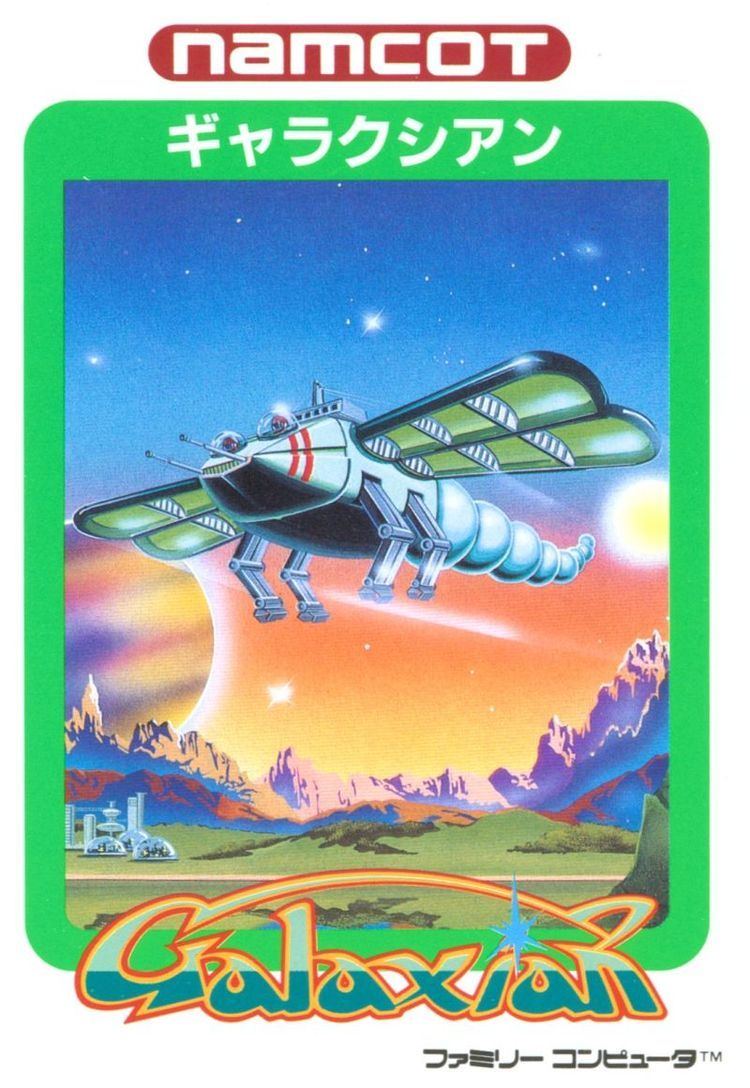 | ||||||||||||||||||||||||||||||||||
Release date(s) JP: October 1979NA: December 1979 Mode(s) Up to 2 players, alternating turns Publishers Namco, Atari, Midway Games, Atarisoft, Bug-Byte, Taito, Bandai Namco Entertainment, Majesco, Dempa Shimbunsha Similar Galaxian games, Namco games, Shoot 'em up games | ||||||||||||||||||||||||||||||||||
Galaxian 1979 namco mame retro arcade games
Galaxian (ギャラクシアン, Gyarakushian) is an arcade game that was developed by Namco and released in October 1979. It was published by Namco in Japan and imported to North America by Midway that December. A fixed shooter game in which the player controls a spaceship at the bottom of the screen, and shoots enemies descending in various directions, it was designed to compete with Taito Corporation's successful earlier game Space Invaders (which was released in the previous year, and also imported to the US by Midway Games).
Contents
- Galaxian 1979 namco mame retro arcade games
- Arcade game galaxian 1979 namco re uploaded
- Description
- Gameplay
- Development and release
- Standard arcade games
- Arcade laserdisc
- Reception
- Legacy
- Ports
- Games featuring elements of Galaxian
- Games featuring the Galaxian flagship
- In the competitive arena
- References
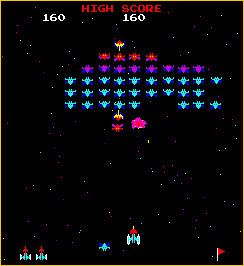
The game was highly popular for Namco upon its release, and has been a focus of competitive gaming ever since. It spawned a successful sequel, Galaga, in 1981, and the lesser known Gaplus and Galaga '88 in 1984 and 1987 respectively, as well as many later ports and adaptations. Along with its immediate sequel, it was one of the most popular games during the golden age of arcade video games.
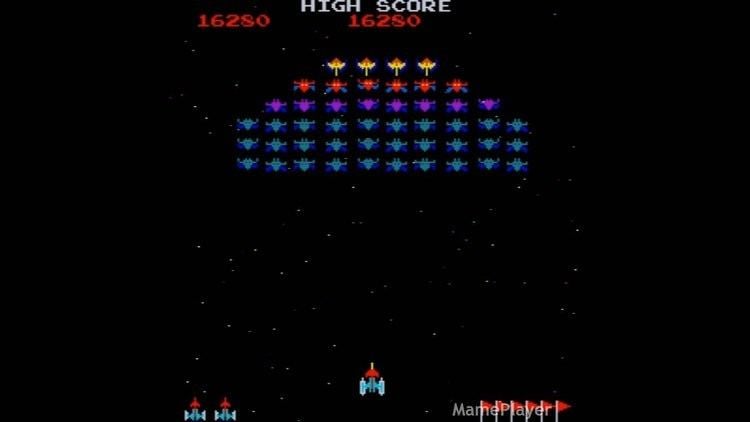
Arcade game galaxian 1979 namco re uploaded
Description
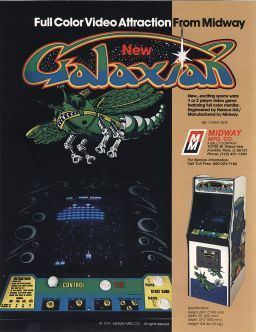
Galaxian expanded on the formula pioneered by Space Invaders. As in the earlier game, Galaxian features a horde of attacking aliens that exchanged shots with the player. In contrast to Space Invaders, Galaxian added an element of drama by having the aliens periodically make kamikaze-like dives at the player's ship, the Galaxip. This made it the first game to feature enemies with individual personalities. The game's plot consists of a title screen that displayed the message "WE ARE THE GALAXIANS / MISSION: DESTROY ALIENS".
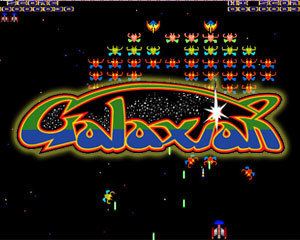
Galaxian was very successful for Namco and introduced several "firsts". Although not the first color video game, Galaxian took RGB color graphics a step further with multi-colored animated sprites and explosions, different colored fonts for the score and high score, the scrolling starfield, and graphic icons that show the number of lives left and how many stages the player had completed. It also features a crude theme song and more prominent background "music." These elements combine to create a look and feel that would set the standard for arcade games in the 1980s such as Pac-Man.
Gameplay
The gameplay is relatively simple. Swarm after swarm of alien armies attack the player's ship that moves left and right at the bottom of the wraparound screen. The ship can only have one shot on screen at a time. The player defeats one swarm, only to have it replaced by another more aggressive and challenging swarm in the next stage. A plain and repetitive starfield scrolls in the background.
Development and release
The game was developed by Namco in 1979, and released in Japan that year. It was designed to build and improve upon the formula of Taito's game Space Invaders, which revolutionized the gaming industry upon its release a year earlier. Galaxian incorporated new technology into its dedicated arcade system board, the Namco Galaxian board. Unlike Space Invaders, which was black and white and featured enemies that could only move vertically and horizontally as they descended, Galaxian had a color screen and enemies that descended in patterns and came from various directions. The result was more complex and difficult game play.
Soon after the Japanese release, Namco partnered with the American company Midway to release the game in North America. Midway had previously published Space Invaders in the market, but had to seek new foreign partners when Taito decided to market their games themselves.
Standard arcade games
Arcade laserdisc
Reception
Video magazine in 1982 reviewed the Astrocade version of Galaxian (named Galactic Invasion), noting that the graphics were inferior to the coin-op and PC versions, but praising the play-action as "magnificent" compared to other console versions. The Astrocade version would later be awarded a Certificate of Merit for "Best Arcade-to-Home Video Game Translation" at the 4th annual Arkie Awards. Arcade Express reviewed the Atari 5200 version in November 1982 and scored it 7 out of 10. Home Computing Weekly in 1983 gave the Spectrum version of Galaxian 3/5 stars describing it as a well-written version and praising the graphics as fast although flickery. Softline in 1983 criticized the Atari 8-bit version of the game for being shipped on ROM cartridge, which raised its cost, and stated that "this game becomes tedious very quickly". Famicom Tsūshin in 1995 scored the Game Boy version of the game a 24 out of 40.
Legacy
Galaxian has spawned several follow-up games. The most popular of these was its immediate successor, Galaga, which largely eclipsed its predecessor in popularity, introducing aliens attacking in intricate formations, multiple shots, and bonus stages. A third game in the series, Gaplus, was released in 1984. As with Galaga, this was a fixed shooter, with limited vertical movement (like Centipede). However, by 1984 the novelty of the Space Invaders formula had faded, and it was no longer successful. A fourth game, Galaga '88, was released in 1987, and imported to North America by Atari Games; and a fifth and final game, Galaga Arrangement, was released as part of the Namco Classic Collection Vol. 1, in 1995.
Ports
The original arcade version of Galaxian has been ported to many different systems. These include:
Coleco also released stand-alone Mini-Arcade tabletop versions of Galaxian, which, along with Pac-Man, Donkey Kong, and Frogger, sold three million units combined. A port for the Game Boy Color was planned, but never released.
Galaxian has also been released as part of the Namco Museum series of collections across several platforms:
Galaxian was also released on Microsoft Windows in 1995 as part of Microsoft Return of Arcade. The game was also released as part of the Pac-Man's Arcade Party 30th Anniversary arcade machine.
The game has also been seen in Jakks Pacific's "Plug It In & Play" TV game controllers.
Galaxian, along with Galaga, Gaplus, and Galaga '88, was "redesigned and modernized" for an iPhone app compilation called the Galaga 30th Anniversary Collection, released in commemoration of the event by Namco Bandai.
Games featuring elements of Galaxian
Games featuring the Galaxian flagship
The Galaxian flagship (also known as the "Galboss") has made numerous cameo appearances in other Namco games (like Namco's signature character Pac-Man and the Special Flag from Rally-X, which also went on to become recurring items in other Namco games).
In the competitive arena
The Galaxian world record has been the focus of many competitive gamers since its release. The most famous Galaxian rivalry has been between British player Gary Whelan and American Perry Rodgers, who faced off at Apollo Amusements in Pompano Beach, Florida, USA, on April 6–9, 2006. Whelan held the world record with 1,114,550 points, until beaten by newcomer Aart van Vliet, of the Netherlands, who scored 1,653,270 points on May 27, 2009 at the Funspot Family Fun Center in Weirs Beach, New Hampshire, USA.
